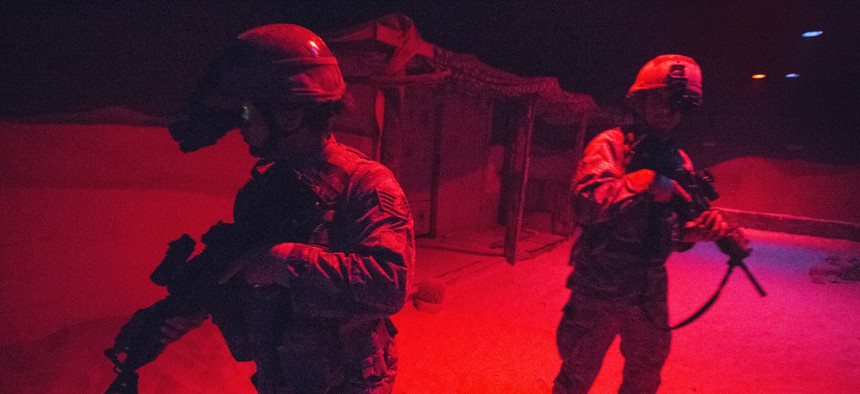
U.S. Air Force Airmen with the 514th Security Forces Squadron, 514th Air Mobility Wing, maneuver through the indoor urban operations site during a training exercise at the New Jersey National Guard's Joint Training and Training Development Center. U.S. Air Force photo by Master Sgt. Mark C. Olsen
How AI Will Soon Change Special Operations
A new SOCOM office is pursuing tools to understand and influence populations, clear rooms with robots, and spot new forms of jamming.
When Gen. Richard D. Clarke was leading special operations forces in Afghanistan years ago, he spent 90 percent of his time thinking about moving and shooting — “the raid, the mission, the kill-capture mission, the destruction of enemy forces,” Clarke said last week at the annual SOFIC conference. But when he returned to Afghanistan last year as the commander of U.S. Special Operations Command, he found that U.S. leaders were focusing most of their mental energy on information.
Commanders now spend about 60 percent of their time mulling what the Taliban and the Afghan population are thinking, and how U.S. actions might influence that, Clarke said. “As we look at the info space and in our fight for competition...working in the information space can have the greatest impact in the coming years.”
Clarke said AI will play a big role in SOCOM’s future information-warfare efforts. This summer, the command will stand up a new office to harness AI for language translation, scanning captured laptops and cellphones, collating and countering Taliban messaging, and more.
“How can I, in real-time, sense what the enemy is stating publicly so we can counter that messaging,” he said, “so we can see what they’re working in the Twittersphere, or what they’re working in the information environment so that we can respond in real-time at the speed of relevance.”
That social information will also play a role in tactical operations. Next year, SOCOM will launch a program to give mission commanders better AI tools, according to James Smith, the command's acquisition executive. One part is creating visualization software that can show relevant tactical information and what Smith described as “SOF-peculiar” data, such as population dynamics, social media trends, sentiment analysis and other social points. All this should give commanders a sense of what’s happening socially and psychologically in the places that they’re operating.
Smith wants “to give our operations centers a much better feel for the operations that SOF is going to be asked to do, both the [countering violent extremism] operations but also in great power competition.”
That information, along with “everything they currently get from a whole cell of analysts” will also flow to operators as part of a “hyper-enabled environment,” said Lisa Sanders, SOCOM’s director of science and technology for special operations forces, acquisition, technology and logistics. “All of that could be moved forward to give me a true, immediate situational picture on the edge."
AI may also help special operators to overcome jamming or detect new electromagnetic threats. “Wouldn’t it be great if we had some kind of machine learning that just identified anomalies in this space,” Smith said. “Maybe it's the new radars we haven’t seen before.”
Related podcast:
On the tactical side, AI will allow aerial and ground robots to take over more dangerous missions, Smith said. “Think of those small UAVs or ground vehicles and giving them enough AI or ML [machine learning] to be autonomous so that they can clear a building or they can clear a tunnel.”
SOCOM is working with the Joint Artificial Intelligence Center on new initiatives, Smith said. But most of the AI that they’ll be paying for will be a part of some other tool or software that they’re buying already. SOCOM is currently pursuing more than 30 efforts that include some AI and machine learning.
“We have to stop thinking about this stuff being futuristic. We have to think about it being baked in,” he said. “We have to start thinking about it being shovel-ready.”




